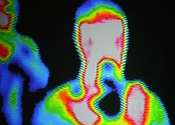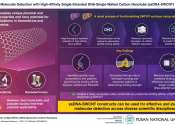Plants & Animals
Bumblebee queens choose to hibernate in pesticide-contaminated soil, scientists discover
An alarming discovery from University of Guelph researchers raises concerns for bumblebee health, survival and reproduction. U of G environmental sciences researchers Drs. Nigel Raine and Sabrina Rondeau have found that bumblebee ...
8 hours ago
0
84
Biochemistry
Lignin molecular property discovery could help turn trees into affordable, greener industrial chemicals
Trees are the most abundant natural resource living on Earth's land masses, and North Carolina State University scientists and engineers are making headway in finding ways to use them as sustainable, environmentally benign ...
4 hours ago
0
23

Controlling sound waves with Klein tunneling improves acoustic signal filtration
In the context of sensory modalities, eyes work like tiny antennae, picking up light, electromagnetic waves traveling at blistering speeds. When humans look at the world, their eyes ...
In the context of sensory modalities, eyes work like tiny antennae, picking up light, electromagnetic waves traveling at blistering speeds. When humans ...
Nanophysics
4 hours ago
0
36

Physicists show that neutron stars may be shrouded in clouds of axions
A team of physicists from the universities of Amsterdam, Princeton and Oxford have shown that extremely light particles known as axions may occur in large clouds around neutron stars. ...
A team of physicists from the universities of Amsterdam, Princeton and Oxford have shown that extremely light particles known as axions may occur in large ...
Astronomy
8 hours ago
0
69

Could injecting diamond dust into the atmosphere help cool the planet?
A multi-institutional team of climatologists, meteorologists and Earth scientists has found evidence that dropping diamond dust from an airplane into the atmosphere could cool the ...
A multi-institutional team of climatologists, meteorologists and Earth scientists has found evidence that dropping diamond dust from an airplane into ...

American lobster population and habitat preferences shifting, study finds
American lobsters along Maine's coast have relocated to new habitats, while the population simultaneously shrunk in abundance and grew older, according to a new study by University of Maine researchers.
Plants & Animals
5 hours ago
0
18

Cellular senescence research identifies key enzyme to promote healthy aging
A team at Kumamoto University has made a discovery that could help promote healthy aging. As the world's population ages, Japan's aging population in particular is growing at an unprecedented rate, making it crucial to extend ...
Cell & Microbiology
5 hours ago
0
70

New fabrication strategy enhances graphene aerogel sensitivity and durability for human-machine interfaces
In recent years, researchers have synthesized various new materials that could be used to develop more advanced robotic systems, devices and human-machine interfaces. These materials include graphene aerogels, ultralight, ...

First results from the Axion Dark-Matter Birefringent Cavity experiment establish a new technique for axion search
Researchers at MIT recently published the first results of an experiment aimed at searching for axion dark matter by probing the axion-induced birefringence of electromagnetic waves. While these findings, published in Physical ...

Team develops promising new form of antibiotic that makes bacterial cells self-destruct
To address the global threat of antibiotic resistance, scientists are on the hunt for new ways to sneak past a bacterial cell's defense system. Taking what they learned from a previous study on cancer, researchers from the ...
Biochemistry
6 hours ago
0
37

Black adults disproportionately affected as glaucoma reaches 4.22 million in the US
A University of Michigan led study finds regional and demographic disparities in glaucoma burden. Results find that 4.22 million U.S. adults had glaucoma in 2022, with 1.49 million living with vision impairment.

DeepMind researchers find LLMs can serve as effective mediators
A team of AI researchers with Google's DeepMind London group has found that certain large language models (LLMs) can serve as effective mediators between groups of people with differing viewpoints regarding a given topic. ...

Discovery of how liver flushes cholesterol from body could lead to better cardiovascular disease treatments
A new discovery about how the liver flushes cholesterol from the body could lead to more effective treatments for cardiovascular disease—the leading cause of death worldwide.
Cardiology
6 hours ago
0
16

The Future is Interdisciplinary
Find out how ACS can accelerate your research to keep up with the discoveries that are pushing us into science’s next frontier
 Medical Xpress
Medical Xpress

In vitro model helps show why breast cancer spreads to bone

How cfDNA testing can reduce pregnancy risks and lower costs

New diagnostic approach for bacterial infections shows promise in the clinic

Can pain be measured objectively, based on science?

Study identifies the genes that drive muscle aging

Innovative mental health training could transform workplaces in Uganda

Family, friends crucial to whether you get screened for cancer
 Tech Xplore
Tech Xplore

DeepMind researchers find LLMs can serve as effective mediators

How farmers can use solar power without damaging the rest of their operation

How a clean energy simulator is helping build a better grid

For Deaf people, train travel can be a gamble—AI-powered Auslan avatar can help

'Age of Electricity' coming as fossil fuels set to peak: IEA

Uncovering new regulatory mechanisms in embryo implantation
Implantation is the initial step in pregnancy, where the embryo attaches to and enters the endometrium, the inner tissue layer of the uterus. During this process, the cells of the endometrium change to build the right conditions ...
Cell & Microbiology
6 hours ago
0
29

New strategy unlocks magnetic switching with hydrogen bonding at molecular level
A research team from Kumamoto University has successfully developed a new approach to create switchable magnetic materials by using hydrogen bonding at the molecular level. Their study shows how certain metal complexes, previously ...
Analytical Chemistry
6 hours ago
0
14

Leveraging skyscraper architecture: New design enhances porosity and structural stability for metal-organic frameworks
The Burj Khalifa, the tallest building in the world, employs advanced construction techniques designed to withstand wind, seismic activity, and its own massive weight. Among these techniques is the "Meta Column System," which ...
Analytical Chemistry
6 hours ago
0
46

Learning without feedback: Neuroscientist helps uncover the influence of unsupervised learning on humans and machines
Imagine a child visiting a farm and seeing sheep and goats for the first time. Their parent points out which is what, helping the child learn to distinguish between the two. But what happens when the child does not have that ...
Psychology & Psychiatry
7 hours ago
0
24

Team achieves successful reproduction of hematopoietic stem cell developmental process in an in vitro culture system
Researchers at Kumamoto University have achieved a notable advancement in stem cell biology by reproducing the developmental process of hematopoietic stem cells (HSCs) in vitro. This culture system not only enhances our understanding ...
Cell & Microbiology
6 hours ago
0
10

Scientists untangle the challenging complexities of radiocarbon in ice cores
ANSTO scientists, Dr. Andrew Smith, Dr. Quan Hua and Dr. Bin Yang have contributed to a paper that elucidates how in situ cosmogenic radiocarbon (14C) is produced, retained and lost in the top layer of compacting snow (the ...
Earth Sciences
6 hours ago
0
29

Butterfly brains reveal the tweaks required for cognitive innovation
A species of tropical butterfly with unusually expanded brain structures displays a fascinating mosaic pattern of neural expansion linked to a cognitive innovation.
Plants & Animals
7 hours ago
0
1

In vitro model helps show why breast cancer spreads to bone
Researchers from Tampere University, Finland, and Izmir Institute of Technology, Turkey, have developed an in vitro cancer model to investigate why breast cancer spreads to bone. Their findings hold promise for advancing ...
Oncology & Cancer
6 hours ago
0
30

Single-molecule imaging reveals aberrant DNA-binding dynamics of cancer-linked chromatin remodelers
Biophysical chemists from the National University of Singapore (NUS) have uncovered a previously hidden landscape that governs the intracellular organization and dynamics of SWI/SNF chromatin remodelers, an important class ...
Cell & Microbiology
7 hours ago
0
1

Key role of structural defects in amorphous solid deformation uncovered
Researchers at the Indian Institute of Science Education and Research (IISER) Pune and the CSIR-National Chemical Laboratory (NCL) Pune have shown that the macroscopic deformation of amorphous solids is controlled by structural ...
Condensed Matter
7 hours ago
0
54

Global coral bleaching event biggest on record: US agency
A global coral bleaching event that began last year has quickly grown to the largest on record, according to a US agency, with the impacted reef area continuing to grow.

Research provides molecular insights into sexual dimorphism of chicken feathers
Birds possess unique skin appendages called feathers that are derived from the outermost layer of skin cells. Feathers are important for several functions, such as flight, temperature regulation, protection from external ...

New genome reconstruction advances thylacine de-extinction efforts
New scientific milestones in the mission to reverse the extinction of the thylacine (Tasmanian tiger) are advancing University of Melbourne research and progressing potential solutions to the broader extinction crisis.

Breathing space—smart parking policies improve city dwellers' lives in EU
Researchers have put in place smart parking set-ups that offer residents across Europe cleaner air, more greenery and space to play.

AI finds racial restrictions in millions of property records
California law requires counties to remove racially restrictive language—constitutionally unenforceable since 1948—from property deeds. Researchers trained a large language model to help.

Drones prove effective way to monitor maize re-growth, researchers report
Maize, or corn, grows tall, with thin stalks that boast ears of the cereal grain used in food production, trade and security globally. However, due to rain, wind and other increasingly extreme weather events, the maize falls ...

Q&A: A faster way to identify drought-resistant plants for crop breeding research
Climate change is making droughts more common and more severe—which makes research into developing drought-resistant crops more important than ever. Now researchers have developed a new framework that should expedite this ...

Schools for the blind can have positive psychological transformative effects on people with visual impairment
Researchers at University of Tsukuba have discovered that for individuals with acquired visual impairments, "segregated placements," such as schools for the blind, play a significant role in fostering positive psychological ...

How to spot AI deepfakes that spread election misinformation
Generative AI systems, such as ChatGPT, are trained on large datasets to create written, visual or audio content in response to prompts. When fed real images, some algorithms can produce fake photos and videos known as deepfakes.

Research finds 1.1 billion people in multidimensional poverty, with nearly a half-billion in conflict settings
New research from the United Nations Development Program (UNDP) and the Oxford Poverty and Human Development Initiative (OPHI) has found that poverty rates in conflict-affected nations are almost three times higher than in ...

Well-being increases when working hours are reduced, finds Germany-wide study
Well-being increases when working hours are reduced—while productivity remains the same or even increases moderately. This was supported by a Germany-wide study conducted by the University of Münster under the scientific ...

North Carolina's hurricane damage is not just destroyed homes, but contaminated water systems, experts say
Hurricane Helene brought death and destruction to North Carolina, with the western part of the state in particular seeing entire towns and homes washed away.

Research reveals potential for community-led housing to empower black and minority ethnic communities
Dr. Tom Moore, a housing and planning research expert at the University of Liverpool, has contributed to pioneering new research which, for the first time, provides a national overview of the challenges faced by black and ...

Materials of the future can be extracted from wastewater
A group of researchers is on the way to revolutionizing what biomass from wastewater treatment plants can be used for. Biopolymers from bacteria can be a sustainable alternative to oil-based products, and phosphorus and other ...

Pioneering river restoration declared a success
A year on from the completion of a three-year project on the National Trust's Holnicote Estate in Somerset to reconnect a section of a river to its floodplain—the innovative "Stage 0" river restoration technique, first ...

An ill kitten in Nebraska sparked efforts to stamp out the spread of rabies
The 2023 illness and death in Nebraska of a stray kitten infected with rabies set off a large-scale effort to discover how the feline became infected in the first place.

Q&A: Experts discuss the beaver, a controversial mammal
When an endangered species succeeds in repopulating its former habitat, the immediate reaction is one of joy. In the long term, however, its spread is often associated with conflict. One example is the beaver, a keystone ...

Collecting taxes on Airbnb home rentals could help curb the rise in housing costs
Home-rental platforms like Airbnb are known to drive up housing costs, but a new study shows that doing a better job of collecting the taxes owed by these home rentals appears to slow the rise in home prices. The finding ...

How extreme weather and costs of housing and insurance trap some households in a vicious cycle
Climate change is increasing the risk of extreme weather events for Australian households. Floods and bushfires are becoming more likely and severe. As a result, household insurance costs are soaring—tripling in some cases. ...

Can NZ's supply chain build enough resilience and sustainability to survive the next global crisis?
New Zealand is highly reliant on trade—particularly on maritime routes, which are lifelines for exports and imports. Key sectors such as agriculture, construction, and wholesale and retail trade depend heavily on this global ...








































































